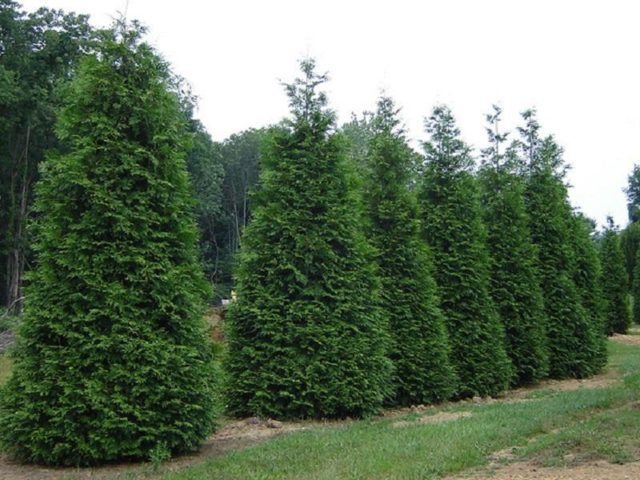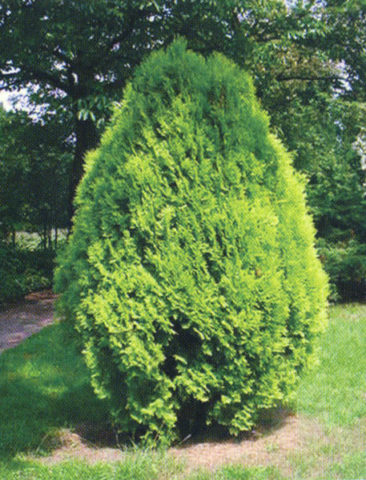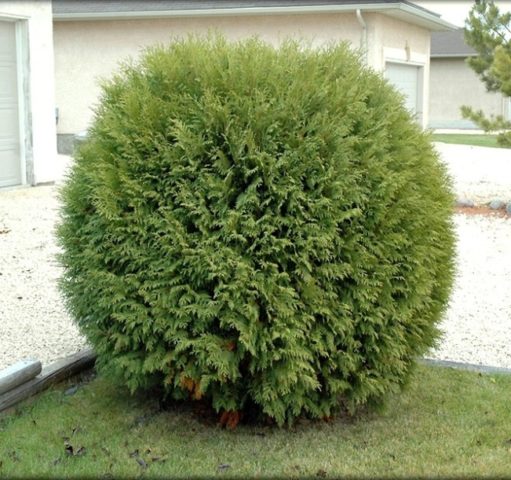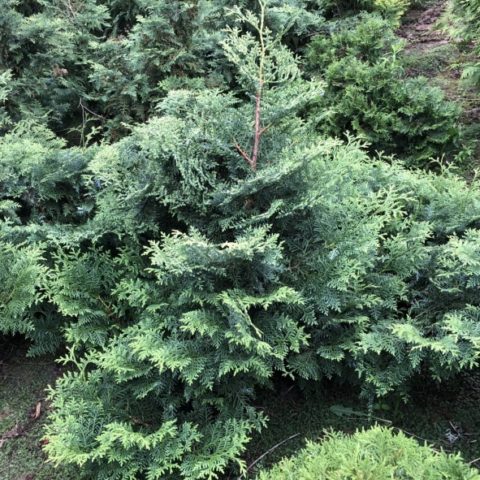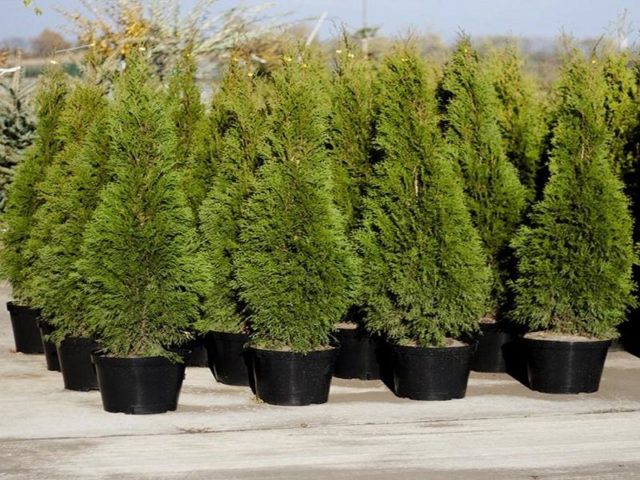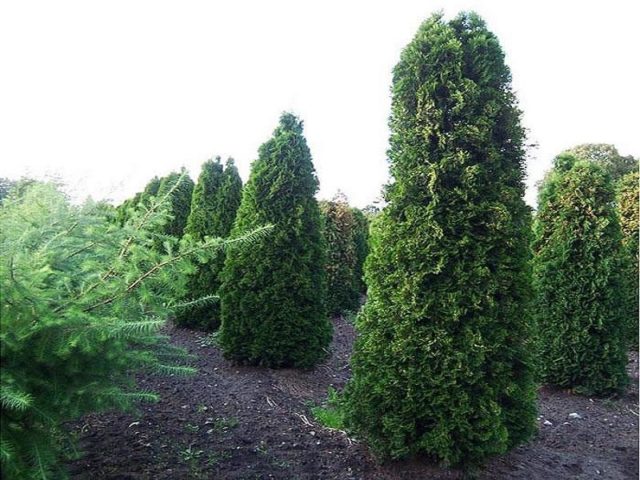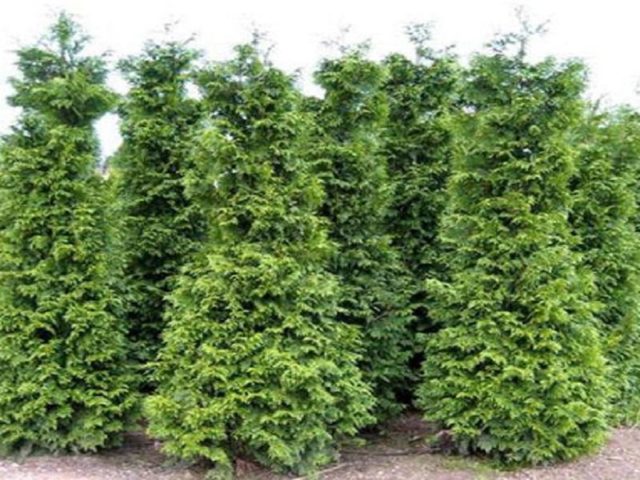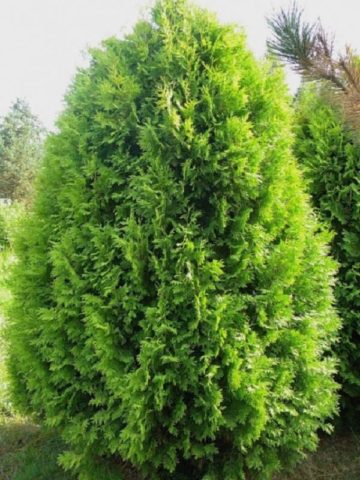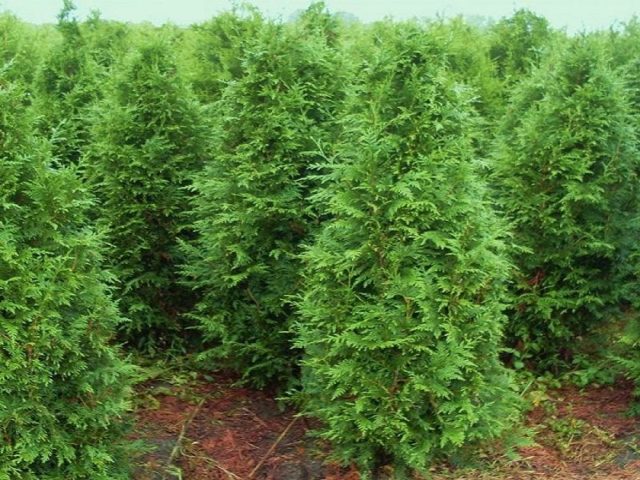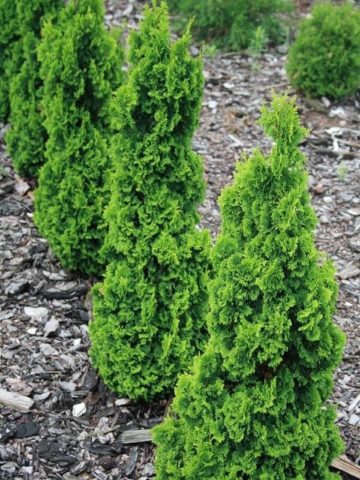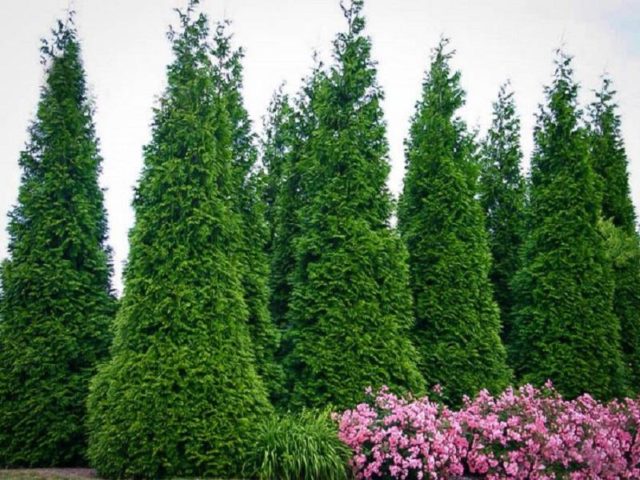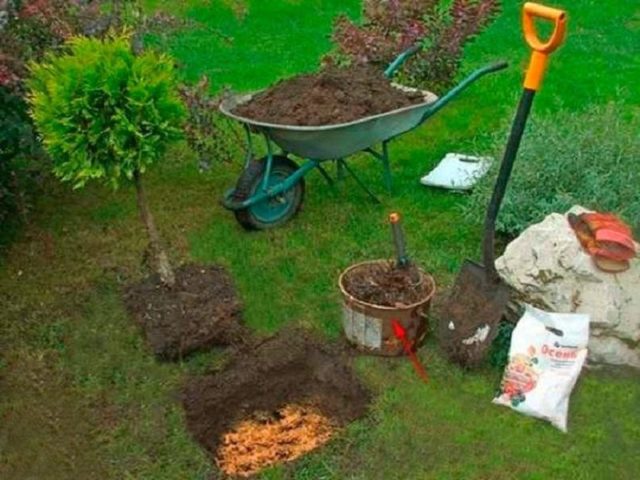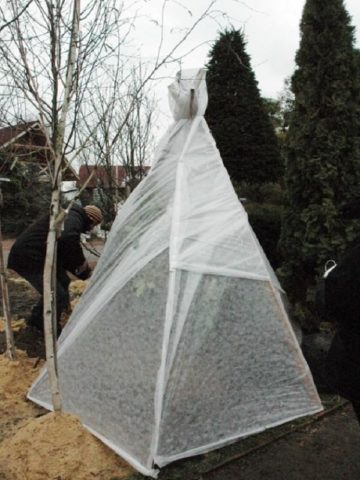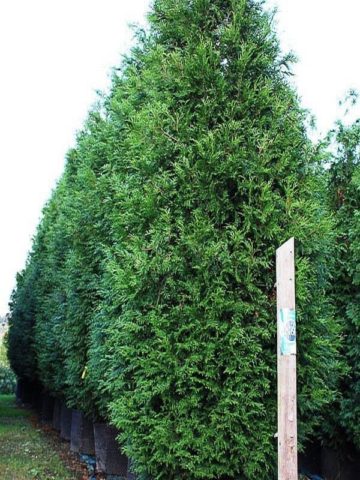Content
The creation of a beautiful and well-groomed plot is the dream of any gardener. Thuja columnar, a beautiful plant that retains its bright appearance throughout the year, will help to carry it out. It has a dense crown, beautiful shapes, and emits a wonderful coniferous aroma.
Columnar thuja has its own peculiarities of planting and care, which you should know about in order to avoid mistakes when growing.
Description of the columnar thuja
Columnar western thuja belongs to the genus Gymnosperms, the Cypress family. Its natural area is considered to be East Asia, America, Europe. On the territory of Russia, in natural conditions, ephedra is not found, but the tree is often grown in personal plots.
Under natural conditions, the height of the columnar thuja reaches 25 m, in the personal plot - no higher than 10 m. The tree has a powerful root system that deeply extends into the soil. The bark of the plant gradually flakes off, its color is brown or red. Crown shape - columnar, can reach 150 cm in width. The branches fit snugly against the trunk. The needles are scaly, saturated green, their complete replacement takes place every two years.
Thuja has no decorative flowers. After the fall of monoecious inflorescences, small brown cones with seeds inside remain on the shoots.
Thuja columnar is an unpretentious frost-resistant plant that tolerates dust and gas pollution well.
Varieties and varieties
There are several main types of thuja:
- western;
- eastern;
- folded;
- japanese;
- korean.
On their basis, numerous varieties of thuja have been bred, having various forms:
Pyramidal, spherical, columnar, dwarf, pillow-shaped.
Many known varieties have a columnar shape.
Brabant
The western columnar thuja Brabant is fast growing. In the adult state, the plant reaches 20 m in height, the diameter of its crown is 4 m, but in the middle lane it does not grow above 5 m.
The annual growth is 40 cm. The crown of the ephedra is compact, branched, dropping to the very ground. Thuja needles are green with golden tips. Its color remains in winter. The variety is classified as shade-tolerant, but the culture does not tolerate thaws well. The use of the western columnar thuja, according to the description of amateur gardeners and specialists, is universal: in the form of individual and group plantings. To maintain its shape, the plant requires periodic pruning.
Columna
Columna is one of the best Western columnar varieties that is bred in Germany. The growth rates of the culture are average. At the age of ten, the plant reaches 4 m in height and 1.5 m in diameter.
Later, thuja can grow up to 10 m. Its crown is narrow, the top is blunt. The branches are directed horizontally, and at the ends they are fan-shaped. The needles of the tree are small, glossy, dark green.
The thuja variety is frost-resistant, unpretentious in care. It is used for hedges and individual plantings. The plant does not need a haircut.
Gelderland
This is a popular variety of columnar thuja (photo) of a folded look. The crown starts from the ground, its shape is conical, dense. The annual growth is 25 cm. An adult tree reaches 5 m. Its needles are soft, green in summer, golden-bronze in winter. Thuja is unpretentious, loves lighted areas, is not afraid of haircuts.The culture is frost and drought resistant.
Holmstrup
Judging by the description and photo, the western columnar thuja Holmstrup has a dense dense crown.
The height of the plant at the age of 10 years is 1.5 m with a crown diameter of 0.6 m. The annual growth of this conifer is 15 cm. In the adult state, the columnar thuja reaches 4 m. Its crown is narrow, the color of the needles does not change in winter. The tree is frost-resistant, undemanding to soil, its use in landscape design is universal. It transfers a haircut easily.
Excelsa
The evergreen columnar folded thuja has a trunk extending to the top and arched branches. The tree grows very quickly, it grows by 30 cm per year.
Its maximum height is 15 m, width - 4 m. The needles of the columnar thuja Excels are dark green, shiny, rough, scaly-like. Fruits are oblong cones 12 mm long. They are green in summer and brown in winter. The plant is shade-tolerant, wind- and frost-resistant, easily tolerates pruning.
Zmatlik
Dwarf columnar thuja forms a narrow crown. At a young age, it is not entirely clear, but rather disheveled and ugly, the trunk can be curved. The growth of an adult tree reaches 1 m. Its needles are small, dark green. The columnar thuja has winding, fan-like branches that create spirals and waves. The plant loves sunny areas; in the shade, its crown thins.
Application in landscape design
Columnar thuja is often used for hedges, which can easily replace conventional fences. At the same time, they not only look great, but also absorb dust and other air pollution. When planted at a distance of 0.5 m, a dense wall of plants is formed.
In the arrangement of rock gardens, dwarf compact columnar thuja are used. Slow-growing varieties allow time to correct the shape of the crown. Thuja can be planted in groups and one at a time.
When organizing mixed flower beds, the principle of a natural landscape should be applied, where different plants are combined. These mixborders look stylish at any time of the year. Together with the columnar thujas, they use saxifrage, heather, red roses, dahlias, astilba, and hydrangeas. The combination of shapes and shades in contrast gives an amazing effect.
The folded thuja perfectly complements the flower garden with its fluffy crown.
Columnar thuja, standing alone on the lawn, decorate it, make it unique, different from many others.
Breeding features
Columnar thuja can be propagated by cuttings or seeds.
The second method takes about 5 years to grow. The decorative properties of the thuja are preserved by this. Ripe cones with seeds are placed in a warm place. After opening them, the seeds are removed, soaked for 10 hours and sown. After a year, the plant reaches a height of 60 cm.
The cutting method involves planting the shoots of a columnar thuja in the fall in a warm and humid place. The composition of the soil includes sand, turf soil, peat. The shoot should be lignified, treated with a growth stimulant. After rooting, the seedling is grown and planted in a permanent place.
Landing rules
Planting a columnar thuja involves performing a number of actions:
- Decide on a site for the location of the thuja.
- Prepare the soil thoroughly.
- Mark the distance between the pits in accordance with the intended purpose (hedges or individual plantings).
- Dig planting holes corresponding to the parameters of the root system of the seedlings.
- Make drainage from expanded clay or broken brick.
- Plant columnar thuja.
- Water the plants.
- Mulch the soil.
- Protect the crown from direct sunlight.
Recommended timing
Experts recommend planting a columnar thuja in early spring. The best time for this is the end of March, as soon as the soil and air warm up. Before winter, the seedling manages to get stronger, grow roots and crown, its shoots coarsen. In this state, the plant hibernates safely. At a later date, it is likely that it will not take root due to the summer heat.
In autumn, the planting of columnar thuja in the middle lane is carried out no later than September. It is better to purchase a plant with a closed root system so that trauma is minimal.
Site selection and soil preparation
When choosing a place and soil for planting a columnar thuja, you should be guided by a number of criteria:
- the site must be well lit;
- in a region with very hot summers, the arrangement of a columnar thuja in a small shade is permissible;
- you should take care of the absence of winds and drafts on the site;
- the soil should be light, fertile, breathable, drained;
- columnar thuja loves acidic soil, on excessively dry or waterlogged - it grows poorly;
- high groundwater levels, marshlands and lowlands should be avoided;
- it is not recommended to plant thuja too close to tall trees, the minimum distance to them is 4 m.
Landing algorithm
After carrying out the preparatory work, you can start planting a columnar thuja:
- Water the seedling liberally 2 hours before planting using a growth stimulant solution.
- Remove the seedling from the pot along with a clod of earth.
- Place it in the center of the pit.
- Fill the voids with soil mixture so that the root collar is 3 cm above the ground surface.
- Water abundantly.
- Top up the soil if the soil has settled.
- Make a roller of earth around the thuja.
- Mulch the near-trunk circle with peat, bark, coniferous litter.
- Shade the crown of a young plant.
Growing and care rules
For the successful growth and development of thuja columnar, it is necessary to carry out regular watering, especially in the first time after planting. Removing weeds, loosening and mulching the soil around the plant helps to retain moisture and its air permeability. Top dressing of thuja is not necessary, but if the soil is poor, then it is worth fertilizing. Pruning is carried out as needed or in order to give a certain shape to the crown.
Watering schedule
If thuja columnar planted in spring or summer, they should be watered regularly, at least once a week. In hot weather, the frequency should be increased to two times every seven days. Watering rate for one plant is 10 liters. In extremely hot conditions, it is doubled.
Experts recommend sprinkling or surface watering in the first month after planting a columnar thuja. It promotes the opening of the pores of the needles, after which it begins to actively emit aroma. The best time to moisturize is in the evening, after sunset.
A plant that has undergone autumn planting needs to be saturated with moisture for successful wintering. At the end of September, it should be watered abundantly.
Top dressing
For feeding the columnar thuja, both organic matter and mineral fertilizers are used. The main principle is "it is better not to feed". Large doses lead to rapid growth, but the shoots become less dense and decorative.
On poor soils, additional nutrients are introduced under the root of the thuja and with the help of sprinkling. Plants need nitrogen in spring, phosphorus in autumn.
It is possible to carry out additional organic fertilizing in the summer - with the help of an infusion of ash, an aqueous solution of slurry in a ratio of 1 to 20.
Pruning
The cutting of a columnar thuja is carried out for sanitary purposes or to give a certain shape to the crown. The time of the event is spring-autumn.
With sanitary pruning, diseased, damaged shoots are removed.
The shape of the crown is given by pruning, carried out according to the rules:
- the optimal plant age is 4 years;
- in one procedure, no more than 1/3 of the shoots are removed;
- the places of the cuts should be treated with garden pitch;
- haircut is carried out in cloudy weather;
- immediately after it, the plant must be watered;
- with a shaping haircut, they create a shape, focusing on the original appearance of a thuja, improving it and slightly correcting it.
Preparing for winter
An adult columnar thuja overwinters well and does not need shelter.
A young plant in the first years after planting may suffer from frost, cold wind, abundance of snow, bright sun in early spring. His defense is carried out in late autumn as follows:
- Over the entire area of the trunk circle, mulch is laid in a layer up to 20 cm thick.
- The crowns of small columnar thujas are covered with non-woven material or bags and fixed with ropes.
- For medium-sized thuja seedlings, frames are made, onto which the covering material is later pulled.
- In winter, it is worth regularly clearing the shelters from snow so that shoots are not damaged under its weight.
- In the spring, the protection is removed gradually so that the needles do not burn.
The level of decorativeness of the columnar thuja next spring depends on the quality of preparation for winter.
Pests and diseases
As you can see in the photo, the western columnar thuja has a wonderful color of needles, attractive shapes.
The plant rarely suffers from diseases and pests. But under unfavorable weather conditions, high humidity or flooding of the root system, fungal diseases may occur: brown shute; rust; gray mold; fusarium.
Damaged shoots are removed and disposed of, and the plants are treated with chemicals.
Among the pests of the columnar thuja, which pose a serious threat to it: bark beetles, sawflies, hermes, scale insects.
To combat them, insecticides and folk remedies are used.
Conclusion
Thuja columnar will not require complex and constant care, if you plant it according to all the rules and choose the appropriate place. The brightness of the color of the needles, the aroma, the stylish look of the plant are the reasons why you should decorate your site with the help of this tree and observe its growth and development for many years.
Testimonials
